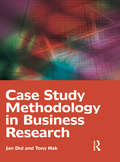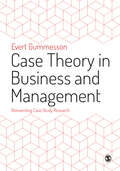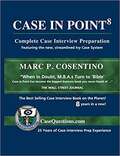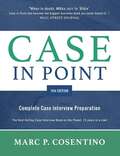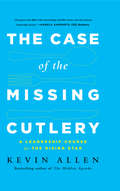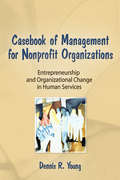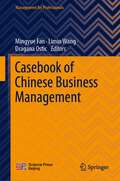- Table View
- List View
Case Study Methodology in Business Research
by Jan Dul Tony HakThe complete guide for how to design and conduct theory-testing and other case studies…Case Study Methodology in Business Research sets out structures and guidelines that assist students and researchers from a wide range of disciplines to develop their case study research in a consistent and rigorous manner. It clarifies the differences between practice-oriented and theory-oriented research and, within the latter category, between theory-testing and theory-building. It describes in detail how to design and conduct different types of case study research, providing students and researchers with everything they need for their project. The main aims are to: * present a broad spectrum of types of case study research (including practice-oriented case studies, theory-building case studies and theory-testing case studies) in one consistent methodological framework. * emphasize and clearly illustrate that the case study is the preferred research strategy for testing deterministic propositions such as those expressing a necessary condition case by case and that the survey is the preferred research strategy for testing probabilistic propositions. * stress the role of replication in all theory-testing research, irrespective of which research strategy is chosen for a specific test. * give more weight to the importance of theory-testing relative to theory-building. Case Study Methodology in Business Research is a clear, concise and comprehensive text for case study methodology. Templates are supplied for case study protocol and how to report a case study. A modular textbook primarily aimed at serving research methodology courses for final year undergraduate students and graduate students in Business Administration and Management, which is also useful as a handbook for researchers.Written by Jan Dul, Professor of Technology and Human Factors, RSM Erasmus University, Rotterdam and Tony Hak, Associate professor of Research Methodology, RSM Erasmus University, Rotterdam, in collaboration with other authors from RSM Erasmus University.
Case Study Research for Business
by Jillian Dawes FarquharThe only case study research textbook written exclusively for students of Business and related disciplines.<P> Using a step-by-step approach, Case Study Research for Business takes you right through the case study research process from research design and data collection using qualitative and quantitative methods, to research analysis, writing up and presenting your work.<P> Key features:<P> - Takes a multidisciplinary approach to case study research design by drawing on research philosophies to improve student understanding of these critical research traditions and hence provide firmer theoretical foundations for their research<P> - Coverage of contemporary topics such as research ethics and access<P> - Packed with practical examples from all areas of business<P> - Pedagogical features include vignettes, exercises and 'cases' which directly relate to business research<P> Case Study Research for Business will prove a valuable resource for undergraduate, postgraduate and research students of business and related disciplines.
Case Study of Targeted Poverty Alleviation in 100 Villages in China: General Report (International Research on Poverty Reduction)
by Peilin Li Houkai Wei Guangjin Chen Yuan MaThis book is the general report of the targeted poverty alleviation and elimination project of 100 villages, presenting the overall progress of poverty alleviation and development of all sample villages in the tide of poverty alleviation. From 2016 to 2018, the project selected 104 poor villages (including those out of poverty) across the country to carry out national research and recorded the great changes in more than 100 poor villages in recent years with steps, nib and lens. Based on questionnaire survey data and data from village research reports, the book describes the basic village situation, poverty situation, village-level poverty management and assistance measures, causes of poverty and assistance measures, progress and results of targeted poverty alleviation in 100 poor villages across China since 2016.
Case Study: The Strategy That Wouldn't Travel (HBR Case Study and Commentary)
by Ravi Venkatesan Martha Maznevski Lloyd Baird Gary Banks Michael C. BeersIn early 1995, Karen Jimenez began implementing a project to boost morale and productivity at Acme Minerals Extraction Co.'s plant in Wichita, Kansas. The team-based productivity project, as it is known, was designed to induce similar results at all of Acme's plants. But now, in the fall of 1996, Jimenez seems to have run into a brick wall at the second site targeted for improvement--the plant in Lubbock, Texas. The tactics that worked so well in Wichita are failing. And, as a meeting with Acme's senior managers looms in this fictional case study, Jimenez must rethink the issues and explain how the project can be put back on track. What can be done? The company has earmarked big bucks for the project, and the CEO's ego and reputation are wrapped up in it. In 96602 and 96602Z, commentators Ravi Venkatesan, Lloyd Baird, Martha Maznevski, and Gary Banks offer advice on this fictional case study.
Case Theory in Business and Management: Reinventing Case Study Research
by Dr Evert Gummesson'This meticulous book submits research and the research process to deep scrutiny. It debunks the unhelpful dichotomy between quantitative and qualitative research and highlights the great value of multi-method and interactive research, approaches that have greatly deepened our thinking.' – Professor Adrian Payne, University of New South Wales, Australia / Professor Pennie Frow, University of Sydney Setting out to dispel the argument that case study research lacks the science, theory and therefore validity of other forms of research, Evert Gummesson combines many decades of experience as both a renowned scholar and a reflective practitioner to effectively bridge the divide between case theory and how it is applied in practice. Bringing the fundamental strengths of cases to the fore, Gummesson introduces the 'Case Theory' concept as an expanded version of case study research which includes both methodology and the types of results that emerge by: Guiding the reader in the theoretical and philosophical underpinning Demonstrating how to translate theory to pertinent research practice that address the real and consequential issues in business and management today. This book will appeal to students, academics and researchers who are interested in the science and philosophy behind case study research as well as the methodology and a thought-provoking read for anyone who wants to be challenged about their belief of case study theory.
Case Theory in Business and Management: Reinventing Case Study Research
by Dr Evert Gummesson'This meticulous book submits research and the research process to deep scrutiny. It debunks the unhelpful dichotomy between quantitative and qualitative research and highlights the great value of multi-method and interactive research, approaches that have greatly deepened our thinking.' – Professor Adrian Payne, University of New South Wales, Australia / Professor Pennie Frow, University of Sydney Setting out to dispel the argument that case study research lacks the science, theory and therefore validity of other forms of research, Evert Gummesson combines many decades of experience as both a renowned scholar and a reflective practitioner to effectively bridge the divide between case theory and how it is applied in practice. Bringing the fundamental strengths of cases to the fore, Gummesson introduces the 'Case Theory' concept as an expanded version of case study research which includes both methodology and the types of results that emerge by: Guiding the reader in the theoretical and philosophical underpinning Demonstrating how to translate theory to pertinent research practice that address the real and consequential issues in business and management today. This book will appeal to students, academics and researchers who are interested in the science and philosophy behind case study research as well as the methodology and a thought-provoking read for anyone who wants to be challenged about their belief of case study theory.
Case for Brand Loyalty
by Susan FournierBrand loyalty is one of the core concepts of the marketing discipline that has enjoyed practical and academic attention for over 75 years. The era of relationship marketing, with its focus on retaining customers for life, has instilled yet greater interest in the concept, precipitating unprecedented growth in frequency programs designed to lock in customer loyalties over time. Despite this rich history, many questions remain about the definition, measurement, and significance of brand loyalty. Some state that brand loyalties are declining and that in today's consumer world, multibrand usage--not brand loyalty--appears the norm. Others feel that the concept of loyalty itself is not outmoded or outdated, but rather that new theoretical and methodological perspectives are required that can revitalize what has become a theoretically uninspired, overly simplistic, and conceptually limiting idea. This case seeks to inform this latter point of view by encouraging students to "see" brand loyalty from the perspective of the consumers that live it. Includes color exhibits.
Case in Point: Complete Case Interview Preparation
by Marc CosentinoMarc Cosentino demystifies the consulting case interview. He takes you inside a typical interview by exploring the various types of case questions and he shares with you the acclaimed Ivy Case System which will give you the confidence to answer even the most sophisticated cases. The book includes 40 strategy cases, ten case starts exercises and 21 ways to cut costs, plus much, much more!
Case in Point: Complete Case Interview Preparation
by Marc P. CosentinoThe world’s foremost authority on case interviewing and bestselling author Marc Cosentino demystifies the case interview process, which is not only used for recruiting in consulting but also in private equity, strategic planning, marketing, logistic, operations, and human capital. He takes you inside a typical interview by exploring the various types of case questions, and he shares with you the acclaimed Ivy Case System. It will give you the confidence to answer even the most sophisticated cases. <p><p>Now in its eleventh edition, Case in Point is the most current and up-to-date book on the subject, and reflects all the latest changes in the case interview process —with plenty of graphs and lessons built in. The book includes dozens of strategy cases, with case starts exercises, 21 ways to cut costs and much more. Case in Point11 helps you build your case cred from start to finish.
Case of the Complaining Customer (HBR Case Study and Commentary)
by Ron Zemke Claus Moller Leonard A. Schlesinger Dinah Nemeroff Tony Goland Dan FinkelmanShortly after installing a new computer system designed to provide quick and accurate service, the president of Presto Cleaner received an angry letter from a customer whose laundry had been lost by the system. The case study looks at the questions: How much service does a company or store owe a customer? Is the customer always right? In 90304 and 90316, four authorities on customer service--Leonard A. Schlesinger, associate professor at the Harvard Business School; Dinah Nemeroff, corporate director of customer affairs at Citicorp/Citibank; Ron Zemke, president of Performance Research Associates; and Claus Moller, president of Time Management International--consider Presto Cleaner's customer complaint.
Case of the Missing Cutlery: A Leadership Course for the Rising Star
by Kevin AllenKevin Allen, author of the Wall Street Journal best-selling The Hidden Agenda: A Proven Way to Win Business and Create a Following, is back, with a fabulously entertaining (and true) tale of a newly minted leader made buoyant during The Case of the Missing Cutlery: A Leadership Course for the Rising Star. As a young manager at an airline catering facility, Kevin had to find out why silverware was disappearing at a rapid clip. The route to solving this mystery of The Case of the Missing Cutlery results in Kevin learning to rise to the occasion, to become a leader who inspires followers and is able to rely on their hard work and support. For those who might find reading about leadership success at the Fortune 50 level inspiring but too far removed from their experience, the author offers up this down-to-earth story of an everyday employee turned rising star. The Case of the Missing Cutlery also provides exercises and further examples to bring the leadership messages home. [This edition contains content previously published as The Buoyant Leader.]
Case of the Part-Time Partner
by Gary W. LovemanThe promotions committee at Meeker, Needham & Ames, a long-established law firm, met to discuss the candidacy of three associates up for partner. The vote was split on the candidacy of Julie Ross, who, although she had exceptional skills and an ability to bring in new business, worked only part-time as an associate. The meeting minutes and the expert commentaries that follow discuss the advantages and disadvantages of having a part-time partner.
Case of the Pricing Predicament (HBR Case Study and Commentary)
by Mary Karr Bruce Moore William Whitescarver Richard T. Lindgren F.G. Buck RogersScott Palmer's most important account, Occidental Aerospace, is pushing for a discount, but Standard Machine Corp., Scott's company, has a long-standing policy of selling its products at list price--discounts are out of the question. Occidental also has plans for two new plants so Standard's bid may affect millions of dollars in future business. And two Asian machine-tool companies have set their sights on Occidental's home market. Has Standard's fixed-price policy outlived its usefulness? In 88205 and 88215, F.G. Rogers, formerly vice-president of marketing at IBM; Bruce Moore, president and CEO of H.R. Krueger Machine Tool, Inc.; Richard T. Lindgren, president and CEO of Cross & Trecker Corp.; and William Whitescarver, president of the Bindery & Forms Press Division of Harris Graphics consider whether Standard's pricing policy can withstand the pressures of new competition and more demanding customers.
Case of the Profitless PC (HBR Case Study and Commentary)
by Larry Keeley Scott Ward George Quesnelle Donna Dubinsky Ruth Veloria Geoff Moore Andy Blackburn Matt Halprin Philip PiferThis fictitious case written by Andy Blackburn, a Boston Consulting Group vice president based in San Francisco, explores the question of how PC companies can make money in the increasingly price-competitive consumer market. The senior staff of Praxim, a multibillion-dollar maker of desktop computers, face some tough questions: Is it possible to make money selling personal computers to consumers? And if so, how? What resources need to be mustered? Where should they be directed? After years of strong profits, Praxim is being dragged down by increasing competition in the consumer segment of the PC market. In response, CEO Jack Thompson has hired a new manager for the consumer division, Linda Marcus, luring her away from a leading packaged-goods company. Linda wants to make Praxim into a trusted brand by putting Praxim's people into retail stores at peak selling times, setting up an 800 number to answer consumers' technical questions in plain English, and bundling extensively. But the other members of the senior staff are skeptical. The vice president of the commercial division argues that PCs are a commodity and urges Linda to concentrate on cutting costs. The chief technology officer wants Praxim to concentrate on developing the next killer app so that it can charge consumers a premium for new technology. The CFO thinks Praxim should cut its losses and mostly give up on the consumer segment. Mindful that continued losses in the consumer segment will pull down Praxim's share price and put his top executives' stock options at risk, Jack is at a loss. Should he try to make money selling PCs to consumers? Can he keep the doubters on his staff from defecting if he goes ahead with Linda's plan? In 98603 and 98603Z, Geoff Moore, Donna Dubinsky, Larry Keeley, George Quesnelle, Scott Ward, and Philip Pifer give Jack their advice.
Case of the Religious Network Group (HBR Case Study and Commentary)
by Laura L. Nash Peter Tufano Raymond A. Friedman Jacquelyn Gates Kim I. Mills Patricia Walker Maureen A. Scully Gregory Poole Jr.GenCorp, a Connecticut-based paper-goods manufacturer, has long supported employee-organized network groups. Its social support group for African-Americans, in fact, has been a particular success, having provided black employees with opportunities to further enhance their careers and helped the company retain top talent, meet its EEO goals, and gain favorable publicity. So when Alice Lawrence, a top accountant at GenCorp, called general manager Bill Thompson about the Christian network group being organized in one of the company's southern plants, Bill hardly flinched. After all, the Christian group was being organized by Russell Kramer, one of the company's most effective plant managers. What could be the problem there? But a couple of years ago, Alice noted, Russell had sent around a companywide letter that talked about the sinful nature of homosexuality. And that letter has made her and other gay and lesbian employees terribly uneasy. To complicate matters, the issue of "Christian rights" in the workplace was being widely discussed on radio talk shows, and several books on the topic had recently been published. An employee had even called the new region's head of human resources to get clarification on the topic. Up until now, GenCorp hadn't placed a lot of restrictions on network groups. But the emergence of a religious group was raising new questions for GenCorp's managers: Should the company accept religious groups or try to stop them? What policy, if any, should GenCorp adopt toward these network groups? In 99405 and 99405Z, Laura Nash, Maureen A. Scully, Gregory Poole, Jr., Jacquelyn Gates, and Kim I. Millis comment on this fictional case study.
Case of the Temperamental Talent
by Lawrence R. RothsteinTidewater Corp. CEO Bob Salinger faces a dilemma: his most valuable employee, boat designer Ken Vaughn, is also his most destructive. Because of his great talent, Vaughn is critical to the company's future growth and profitability. But his antagonism toward Tidewater's recent reorganization is causing disruptions all over the company, and Vaughn has become increasingly violent. If Salinger fires Vaughn, he risks losing him to a competitor, who would than be in position to grab Tidewater's market share. But if he keeps Vaughn, the company's necessary reorganization may be seriously damaged. Salinger is waffling in the decision and has made a tough situation even worse.
Case of the Unequal Opportunity
by Mary GentileLaura Wollen, group marketing director for ARPCO, was about to recommend her best product manager, Charles Lewis, for a position in the London office. Yet David Abbott, Wollen's counterpart in the United Kingdom, admitted that Lewis looked good on paper, but doubted he would fit in with the team and adjust to the British market. Wollen finally understood that Abbott's reservations were because Lewis was black. Wollen was wary of promoting Lewis into the London job only to have him fail there because of racism. Four experts analyze her alternatives.
Case of the Unhealthy Hospital
by Anthony R. KovnerBlake Memorial Hospital was in poor financial health, due to rising costs and stagnating revenues. The hospital's quality of care was also a major problem, and its clinics were losing over $250,000 a year. As the new CEO worked on the 1992 budget, he saw he would have to cut some services in order to fund others. One service he was considering cutting was the clinic program. Experts from public service and health care comment on the issues.
Case of the Unidentified Industries--1995
by William E. FruhanHelps students to understand how the characteristics of a business are reflected in its financial statements.
Case of the Unidentified Industries--2006
by William E. FruhanHelps students to understand how the characteristics of a business are reflected in its financial statements.
Case of the Unpopular Pay Plan
by Tom EhrenfeldAfter launching a new quality program, the CEO of Top Chemical Co. was searching for a team-based compensation program that would reflect his company's new philosophy. A committee was formed to discuss the options. The compensation vice president explained his idea for paying teams based on their performance, making pay an incentive for continued improvement and overall excellence of the team. The plan met with resistance from employees at all levels of the company. What seemed like a simple idea for a pay plan turned into a very complicated matter. Four experts on compensation reveal where Top Chemical went wrong in its plan and how the CEO might bring about change successfully.
Case-based Evidence - Grundlagen und Anwendung: Prognose und Verbesserung der Akzeptanz von Produkten und Projekten
by Meike Schumacher Georg Rainer HofmannDas Praxisbuch erl#65533;utert anschaulich anhand konkreter F#65533;lle, wie Analogien f#65533;r die Prognose und Erh#65533;hung der Akzeptanz neuer Produkte und Projekte genutzt werden k#65533;nnen. Der Leser erh#65533;lt eine ,,Schritt f#65533;r Schritt Anleitung" zur Methodenanwendung mit zahlreichen Hinweisen und Best-Practice Beispielen. Die Autoren erl#65533;utern allgemein verst#65533;ndlich die Teilschritte der Methode: Zun#65533;chst werden die kritischen Ph#65533;nomene identifiziert. Analogieschl#65533;sse ausgew#65533;hlter Vergleichsf#65533;lle werden auf den aktuellen Fall #65533;bertragen. Diese isomorphen Mechanismen bilden die Grundlage eines synoptischen Modells, welches schlie#65533;lich in einer Serie qualifizierter Experteninterviews evaluiert wird. Das Buch richtet sich an Fachkr#65533;fte aus Gesch#65533;ftsentwicklung und Innovationsmanagement, aber auch an Praktiker aus Produktentwicklung und Marketing.
Casebook Management For Non-Profit Organizations: Enterpreneurship & Occup
by Simon Slavin Dennis YoungAn essential and unique contribution to the social organizational literature, Casebook of Management for Nonprofit Organizations highlights the importance of good management to human service organizations. Author Dennis Young uses case studies that stress entrepreneurship and are addressed to particular aspects of human services management--the processes of new program development and the management of organization change. Written in nontechnical, readable language, the cases deal with a wide array of types of organizational change, ranging from development of new programs to the birth of new organizations, the merger of organizations, and the expansion and diversification of the service offerings of various agencies. Moreover, the cases touch on many other intrinsic aspects of organizational administration including management of professionals and other staff, working with trustees, financing programs through government and private sources, coping with governmental regulatory processes, and managing relationships with organizational clients and constituent groups.
Casebook of Chinese Business Management (Management for Professionals)
by Limin Wang Mingyue Fan Dragana OsticThis book selects Chinese excellent enterprise management cases, integrating into the education system of business schools, sharing "China's new story" to readers, and boosting the process of national economic construction and enterprise transformation. Chinese enterprises face unprecedented opportunities and challenges under the circumstance of fast-changing technology, economy, and political environment. In the face of various uncertainties, they have risen to prominence and constantly summed up enterprise management concepts and practical experience suitable for their own development to reshape their competitive advantages and enhance their market value. Based on the investigation, this book covers the major theoretical aspects of management principles such as planning, organizing, leading, controlling, and innovation. The 17 selected cases from manufacturing, retailing, technology/big data service, agriculture, and other industries cover strategic management, entrepreneurial management, human-oriented management, information management, and organizational innovation management. We hope that readers can get some valuable practical experience and enlightenment from the practices in these fields. The book also includes two case study guides, which guide readers to form a case study's thinking. It also encourages readers to broaden their learning ideas on management.
Caselets: Bribery and Extortion in International Business
by Louis T. Wells Jr."Caselets" present several examples of decisions involving bribery or take other actions that could be considered as corrupt.
